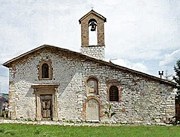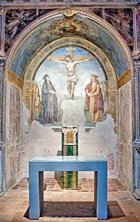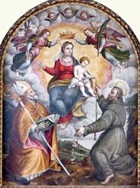


This church, which is also known as the Chiesa della Vittorina, was probably named for the nearby Roman road, Via Vittorina. (However, tradition insists that it was named in honour of the victory of Gubbio over raiding Saracens in 853, which presumably occurred nearby). This was the site of a huge necropolis that was in use from the 5th century BC until the 2nd century AD.
The famous meeting of St Francis and the wolf of Gubbio is said to have occurred in nearby woods in 1206, as commemorated by a bronze relief (1973) outside the church. The church belonged to the Benedictines of the Abbazia di San Pietro at that point, but Bishop Villanus (1206-38) prevailed upon them to give it to the first Franciscans in Gubbio, who built a simple hermitage nearby. This settlement was thus broadly contemporary with that of the Portiuncula outside Assisi.
The Franciscans moved into the city in ca. 1240, where they built the church and convent of San Francesco. Santa Maria della Vittoria passed to a community of Poor Clares, who lived here until 1514.
Exterior
The portal and window in the façade date to the 16th century remodelling, but the tiny window in the apse is original and has interesting carving above it. (There is a lovely picture in Bill Thayer’s website)
Interior
The interior was completely remodelled in the 16th century. The frescoed mock-coffered ceiling dates to this point.
Frescoes (15th century)
These frescoes on the left wall depict:
-
✴the Madonna and Child with SS Sebastian, Roch and Dominic; and
-
✴the Madonna and Child with St Roch and an unknown saint.
Crucifixion (ca. 1500)

Madonna and Child with saints (1597)

Scenes from the life of the Virgin (16th century)
These 14 frescoes extend along both side-walls, forming friezes below the frescoed mock-coffered ceiling. [By/attributed to Virgilio Nucci, Felice Damiano and others]

